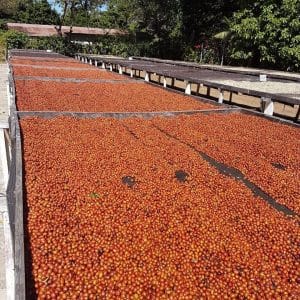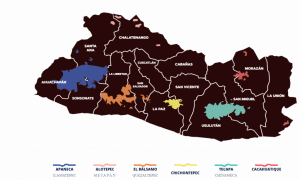EL SALVADOR
WHAT TO EXPECT FROM NEXT CROP 2022/2023 ?
WHAT TO EXPECT FROM NEXT CROP 2022/2023 ?
El Salvador is well known among coffee industry experts for its high-quality, shade-grown Arabica coffee. Indeed, it is the homeland of two of the most prized varietals, Pacas and Pacamara.
THE CAFFINATED HISTORY OF EL SALVADOR
During the 1970s, El Salvador enjoyed a prominent position as a major player in the coffee industry. It was recognised as the 4th-largest coffee producer globally, a remarkable achievement attributed to the modernization initiatives undertaken in the 1950s. These efforts encompassed the implementation of fertilizers, innovative pruning systems, and enhanced farming practices. Between 1960 and 1990, the country consistently maintained an average annual production of 2.5 million 60kg bags.
Regrettably, in recent years, coffee output has experienced a significant decline, falling below the one million 60kg bags mark. Several factors contribute to this decline.
➤ Furthermore, the extended period of low prices during the early years of the present century resulted in a significant decline in production.
In the Tenties, more specifically during the 2013/14 crop season, Promecafe recorded a significant 54% drop in El Salvador’s crop, mainly attributed to rust attack. This decline was particularly pronounced on farms that primarily grew Bourbon, a variety highly vulnerable to rust attacks.
Despite a noticeable decline in coffee production compared to the glory seventies, El Salvador remains celebrated for its exceptional shade-grown coffee varieties. Among the most sought-after are: Pacamara, a coffee variety resulting from the crossing of Pacas and Maragogype, and distinguished by its unique characteristics. Pacas, a natural mutation of Bourbon, sharing similarities with Caturra in Brazil and Villa Sarchi in Costa Rica. And Bourbon, a tall growing plant known for its low yields and exceptional cup quality.
NEW CROP 2022/2023 – BRIEFING
QUALITY
Persistent labor shortages and rising prices of agricultural products led some producers to legitimately worry about the viability and success of this crop.
Fortunately, however, it is now announced that it will be a successful harvest, partly due to the abundant rainfall. Unlike previous years, there were no major storms prior to the harvest that could damage the trees. The drying phase was also beneficial as no rain fell; this allowed the coffee beans to dry evenly and develop the desired properties.
Despite the earlier mentioned challenges, everyone is relieved and reassured about the current state of affairs, and excited about the good quality of this crop.

TRADE
According to Consejo Salvadoreño del Café -the country’s coffee institute, El Salvador’s coffee production is expected to reach 650,000 (60kg bags) for 2022/23 crop. The Salvadoran coffee sector continues to struggle mainly due to climate vulnerability.
The lack of labor is affecting coffee farm activities, including, pruning, tree renovation, and coffee berry picking and processing. In addition, prices for fertilizers and other inputs remain high, thus increasing coffee production costs. In April 2021, the Government of El Salvador (GOES) announced a coffee sector rescue program that included renovation of approximately 35,000 hectares, as well as debt re-structuring. However lack of funding has placed this plan on hold.
The United States is expected to be the main export destination for Salvadoran coffee, reaching approximately 276,137 (60kg bags), or about 44 percent of total exports. Belgium has become the number two export destination accounting for approximately 9 percent of total exports. Other important destinations are Germany, Italy, and Japan. South Korea and Australia are slowly increasing purchases of Salvadoran coffee, accounting for almost 7 percent of total exports.
EL SALVADOR COFFEE COMMUNITY HIGHLIGHTS
LOCAL CENTRAL AMERICAN OFFICE
Our office for Central America (Guatemala), is located on the road to El Salvador (about 225 kilometers) from the farms we work with. Our colleagues in Guatemala visit our partners on a regular basis.
PRODUCER & ROASTER FORUM (PRF) – MARCH 2023
Last March, the PRF event returned to El Salvador for the first time since 2016 with an impressive line-up of speakers, workshops, and panel discussions. The world’s largest producer-focused event, now in its sixth instalment, was held in the Salamanca Exhibition Center in San Salvador. It drew thousands of visitors from across the globe, including from Europe, China, the US, Kenya, and Colombia.
Our CUPRIMA team participated in the event together with our long-term coffee partner Fernando Alfaro. Third generation of a coffee business family, Fernando is managing beneficio El Carmen in Concepcion de Ataco.
The best lots from the new crop (washed, honey, natural & anaerobic process) were cupped in preview.
CUP OF EXCELLENCE 2023
One of our esteemed partners Mr Carlos Mendez has achieved the remarkable feat of becoming a finalist in the prestigious Cup of Excellence 2023. The auction will take place at the end of July 2023. Let’s cheer him on the sidelines!
COFFEE REGIONS – EL SALVADOR
Although separate, well-defined regions, some would argue that El Salvador itself is so small that it can be classified as a single region, with clearly defined areas where coffee grows.
Let’s guide you through these 6 clearly defined coffee regions.

Apaneca-Ilamatepec mountain range
Despite the volcanic activity in the area, this region produces many award-winning coffees. The Santa Ana volcano erupted in 2005 and had a significant influence on production for a few years. This is the country’s most productive region, and it is likely that coffee was first grown in El Salvador here.
➤ Altitude: 500–2,300m (1,600–7,500ft)
➤ Harvest: October–March
➤ Varieties: 64% Bourbon, 26% Pacas, 10% others
Alotepec-Metapan mountain range
This mountain range is one of El Salvador’s wettest, receiving over a third more rainfall than the national average. Despite its proximity to Guatemala and Honduras, the coffees produced in this region are distinct and unique.
➤ Altitude: 1,000–2,000m (3,300–6,600ft)
➤ Harvest: October–March
➤ Varieties: 30% Bourbon, 50% Pacas, 15% Pacamara, 5% others
El Bálsamo-Quezaltepec mountain range
From high on the flanks of the Quetzaltepec volcano, several of the coffee fields in this region have a view of the capital city of San Salvador. Bálsamo refers to an aromatic resin produced by native Balsam trees that grow over 100 feet tall. These trees provide shade that become the perfect ecosystem for coffee grown on the nutrient rich mountain side of San Salvador Volcano and Quezaltepec valley.
The pre-Hispanic people lived in this area; the Quetzalcotitán civilization worshipped Quetzalcoatl, a feathered serpent god who is still a popular icon in Salvadoran society today.
➤ Altitude: 500–1,950m (1,600–6,400ft)
➤ Harvest: October–March
➤ Varieties: 52% Bourbon, 22% Bourbon, 26% mixed & others
Chinchontepec mountain range
Coffee was a ‘latecomer’ to this region in the country’s center, with only fifty bags of coffee produced in 1880. The volcanic ground, on the other hand, is exceptionally fruitful, and today the area is home to numerous coffee growers.
Planting alternating rows of coffee and orange trees for shade is still a typical practice; some say this adds an orange blossom flavour to the coffee, while others ascribe this gentle citrus accent to the Bourbon variety produced here.
➤ Altitude: 500–1,000m (1,600–3,300ft)
➤ Harvest: October– February
➤ Varieties: 71% Bourbon, 8% Pacas, 21% mixed & others
Tepeca-chinameca mountain range
This region is the third-largest producer of coffee in the country. Here they serve coffee with corn tortillas called tostadas, made with salt and dusted with sugar or made with a little panela (cane sugar).
➤ Altitude: 500–2,150m (1,600–7,100ft)
➤ Harvest: October–March
➤ Varieties: 70% Bourbon, 22% Pacas, 8% mixed & others
Cacahuatique mountain range
Captain-General Gerardo Barrios was the first Salvadorian president to see the economic possibilities of coffee, and it is said that he was one of the first to plant coffee in El Salvador, on his land near Villa de Cacahuatique, today is known as Ciudad Barrios.
Clay is abundant in this mountain range, which is used to manufacture pots, platters, and decorative things. Farmers in this area frequently have to dig enormous holes in the clay-like soil and fill them with rich dirt before planting their young trees.
➤ Altitude: 500–1,650m (1,600–5,400ft)
➤ Harvest: October–March
➤ Varieties: 65% Bourbon, 20% Pacas, 15% mixed & others
REFERENCES, KUDOS & INSPIRATION
Special thanks to Sébastien Adant -EFICO Central America- for the intel.
USDA – Coffee Annual
Promecafé
World Coffee Research – El Salvador
Producers Roaster Forum
Cup of Excellence 2023 – El Salvador
CUPRIMA – The Cup of Excellence, Why it Matters